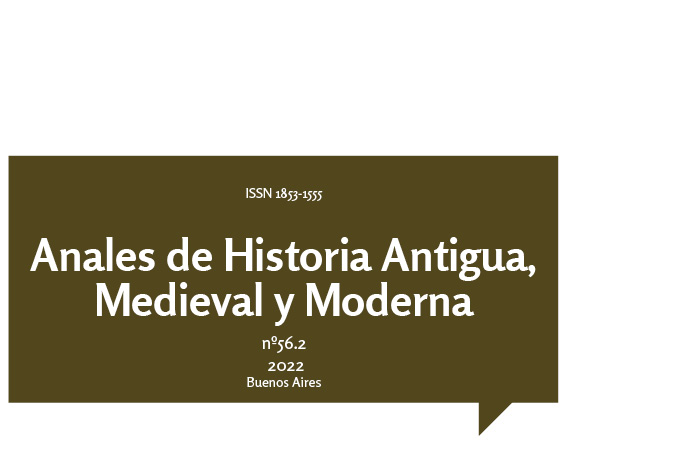El significado histórico de la rivalidad entre alamanes y burgundios en el siglo IV
Resumen
Este trabajo pretende reflexionar respecto de los motivos subyacentes a la rivalidad entre alamanes y burgundios de la que dan cuenta las fuentes latinas. Para ello, realizaremos un estudio comparativo entre ambos pueblos con el fin de problematizar la interpretación tradicional según la cual el motivo de la discordia residiría en la diversidad de sus estructuras políticas.Descargas
Citas
Anderson, W. B. (Trad.). (1936). Sidonius: Poems and Letters, Books 1-2. Cambridge: Harvard University Press.
Bird, H. W. (Trad.). (1994). Aurelius Victor: De Caesaribus (Translated Texts for Historians 17). Liverpool: Liverpool University Press.
den Boeft, J., Drijvers, J. W., den Hengst, D. y Teitler, H. C. (2011). Philological and Historical Commentary on Ammianus Marcellinus XXVIII. Leiden-Boston: Brill.
Brather, S. (2002). Ethnic Identities as Construction of Archaeology: The case of the Alamanni. En A. Gillet (Ed.), On Barbarian Identity. Critical Approaches to Ethnicity in the Early Middle Ages (149-175). Turnhout: Brepols.
Burns, T. S. (2003). Rome and the Barbarians 100 B.C.-A.D. 400. Baltimore: The Johns Hopkins University Press.
Cary, E. (Trad.). (1927). Dio Cassius: Roman History, Volume IX, Books 71-80. Cambridge-Londres: Harvard University Press.
Crump, G. (1975). Ammianus Marcellinus as a Military Historian. Wiesbaden: Franz Steiner VerlagGmbH.
Drinkwater, J. F. (2007). The Alamanni and Rome 213-496 (Caracalla to Clovis). Oxford: Oxford University Press.
Ghosh, S. (2007). On the Origins of Germanic Heroic Poetry. A Case Study of the Legend of the Burgundians. Beiträge zur Geschichte der deutschen Sprache und Literatur, 129, 220-252.
Ghosh, S. (2016). Writing the Barbarian Past: Studies in Early Medieval Historical Narrative. Leiden-Boston: Brill.
Gillett, A. (2002). Introduction: Ethnicity, History, and Methodology. En A. Gillett (Ed.), On Barbarian Identity. Critical Approaches to Ethnicity in the Early Middle Ages (1-18). Turnhout: Brepols.
Goffart, W. (2006). Barbarian Tides. The Migration Age and the Later Roman Empire. Filadelfia: University of Pennsylvania Press.
Guzmán Armario, F. J. (2009). Romanos y bárbaros en las fronteras del Imperio romano según el testimonio de Amiano Marcelino. Madrid: Signifer.
Halsall, G. (1995a). Early Medieval Cemeteries. An Introduction to Burial Archaeology in the Post-Roman West. Glasgow: Cruithne Press.
Halsall, G. (1995b). Settlement and Social Organization. The Merovingian Region of Metz. Cambridge: Cambridge University Press.
Halsall, G. (1996). Female Status and Power in Early Merovingian Central Austrasia: the Burial Evidence. Early Medieval Europe, 5, 1-24.
Halsall, G. (1998). Burial, ritual and Merovingian society. En J. Hill y M. Swan (Eds.), The Community, the Family and the Saint: Patterns of Power in Early Medieval Europe (325-338). Turnhout: Brepols.
Halsall, G. (2007). Barbarian Migrations and the Roman West, 376-568. Cambridge: Cambridge University Press.
Harto Trujillo, M. L. (Ed. y Trad.). (2002). Amiano Marcelino, Historia. Madrid: Akal.
Heather, P. (1991). Goths and Romans, 332-489. Oxford: Clarendon Press.
Heather, P. y Matthews, J. (Eds. y Trads.). (1991). The Goths in the Fourth Century. Translated Texts for Historians, Volume 11. Liverpool: Liverpool University Press.
Heinzle, J. (1994). Das Nibelungenlied: eine Einführung. Fráncfort del Meno: Fischer Taschenbuch-Verlag.
Hummer, H. J. (1998). The Fluidity of Barbarian Identity: the Ethnogenesis of Alemanni and Suebi, AD 200-500. Early Medieval Europe, 7, 1-27.
James, E. F. (2009). Europe’s Barbarians, AD 200-600. Londres-Nueva York: Routledge.
Kaiser, R. (2004). Die Burgunder. Stuttgart: Verlag W. Kohlhammer.
Liebeschuetz, J. H. W. G. (2015). East and West in Late Antiquity: Invasion, Settlement, Ethnogenesis and Conflicts of Religion. Leiden-Boston: Brill.
López Quiroga, J. (2011). Gentes Barbarae. Los bárbaros, entre el mito y la realidad. Murcia: Universidad de Murcia.
Matthews, J. F. (1989). The Roman Empire of Ammianus. Londres: Duckworth.
Miles, R. (1999). Introduction: Constructing Identities in Late Antiquity. En R. Miles (Ed.), Constructing Identities in Late Antiquity (1-15). Londres-Nueva York: Routledge.
Müller, J. D. (2009). Das Nibelungenlied. Berlín: Erich Schmidt Verlag GmbH & Co.
Peterson, W. (Trad.). (1914). Tacitus. Dialogus. Agricola. Germania. Londres: William Heinemann.
Pohl, W. (2004). Die Germanen. Múnich: Oldenbourg Wissenschaftsverlag GmbH.
Rackham, H. (Trad.). (1942). Pliny: Natural History, Volume II, Books 3-7. Cambridge-Massachusetts: Harvard University Press.
Rike, R. L. (1987). Apex Omnium. Religion in the Res Gestae of Ammianus. Berkeley-Los Angeles: University of California Press.
Rix, R. W. (2015). The Barbarian North in Medieval Imagination. Ethnicity, Legend and Literature. Nueva York: Routledge.
Rolfe, J. C. (Trad.). (1935). Ammianus Marcellinus: Roman History, Volume I, Books 14-19. Cambridge-Londres: Harvard University Press.
Rolfe, J. C. (Trad.). (1939). Ammianus Marcellinus: Roman History, Volume III, Books 27-31. Cambridge-Londres: Harvard University Press.
Ruchesi, F. C. (2015). Unidad y cohesión social en el ejército romano tardío: el caso de los bárbaros. Buenos Aires: Facultad de Filosofía y Letras.
Sánchez Vendramini, D. N. (2016). Paideia and Self-fashioning in Ammianus Marcellinus. Histos. The Online Journal of Ancient Historiography, 10, 34-64.
Stevenson, E. L. (Trad.). (1991). Claudius Ptolemy: The Geography. Nueva York: Dover Publications, Inc.
Todd, M. (2004). The Early Germans. Second Edition. Oxford: Blackwell.
Wenskus, R. (1961). Stammesbildung und Verfassung. Das Werden der frühmittelalterlichen gentes. Colonia-Graz: Böhlau Verlag.
Wolfram, H. (1988). History of the Goths. Los Angeles: University of California Press.
Wolfram, H. (1997). The Roman Empire and Its Germanic Peoples. Los Angeles-Londres: University of California Press.
Wood, I. N. (1994). The Merovingian Kingdoms. 450-751. Nueva York: Longman.
Wood, I. N. (2003). Gentes, Kings and Kingdoms. The Emergence of States: The Kingdom of the Gibichungs. En H.-W. Goetz, J. Jarnut y W. Pohl (Eds.), Regna and Gentes. The Relationship between Late Antique and Early Medieval Peoples and Kingdoms in the Transformation of the Roman World (243-269). Leiden-Boston: Brill.
Wood, I. N. (2004). Misremembering the Burgundians. En W. Pohl (Ed.), Die Suche nach den Urprüngen (139-148). Viena: Österreichische Akademie der Wissenschaften.
Wood, I. N. (2014). The Political Structure of the Burgundian Kingdom. En M. Meier y M. Patzol (Eds.), Chlodwigs Welt: Organisation von Herrschaft um 500 (383-396). Stuttgart: Franz Steiner Verlag.
Derechos de autor 2023 Anales de Historia Antigua, Medieval y Moderna

Esta obra está bajo licencia internacional Creative Commons Reconocimiento-CompartirIgual 4.0.








